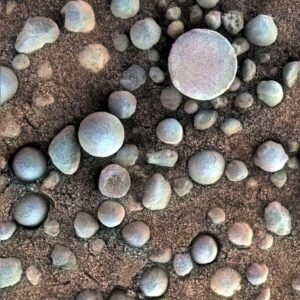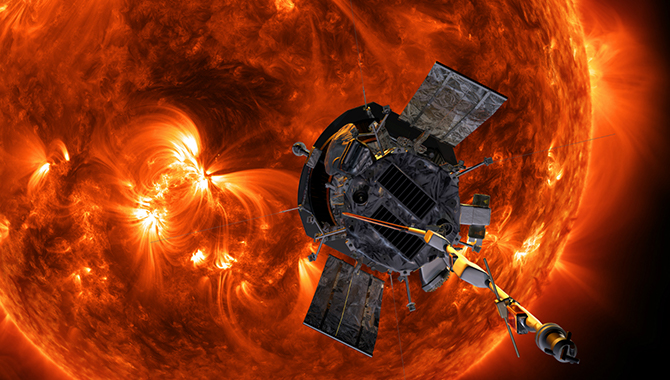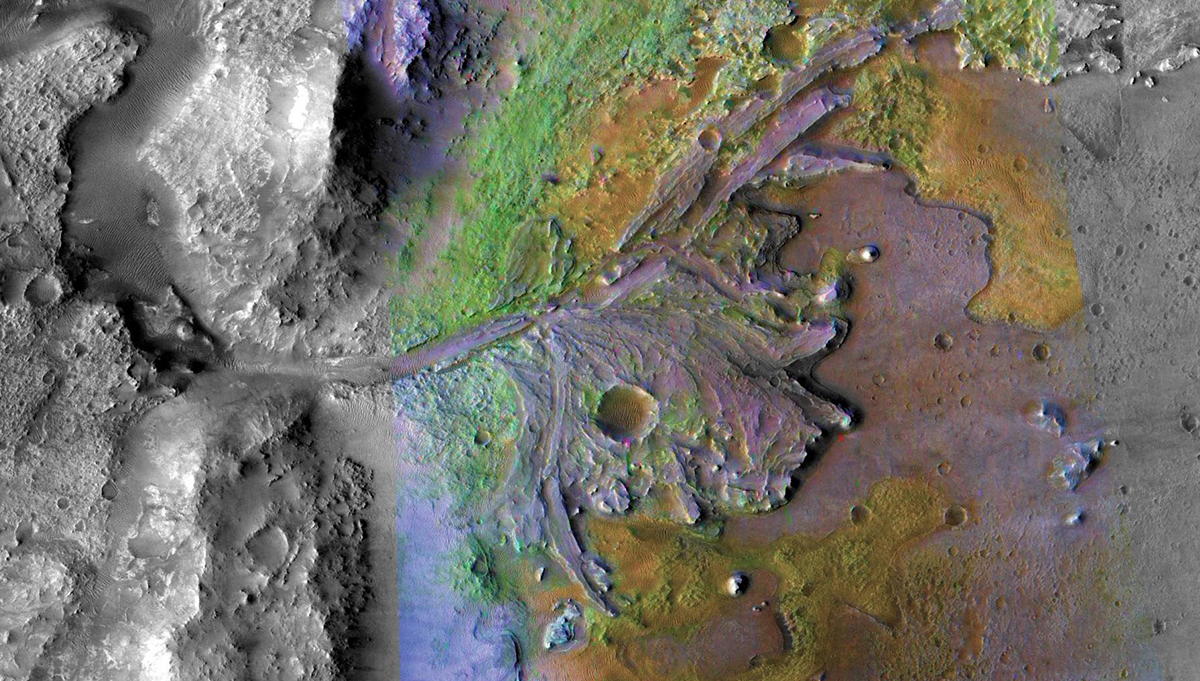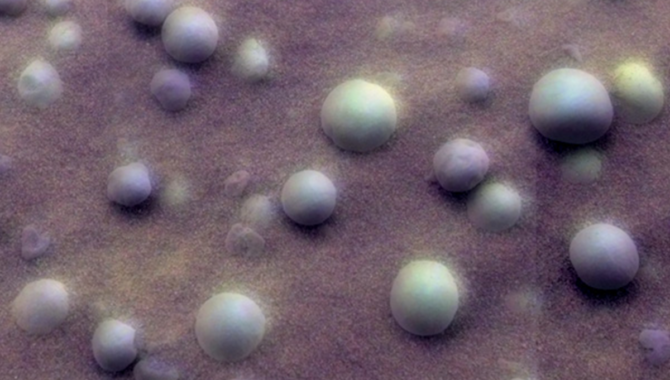
This mosaic image by the Opportunity rover shows an extreme close-up of the round, blueberry-shaped formations in the Martian soil at Meridiani Planum that were discerned to be hematite concretions formed when the area was soaked with water in the distant past. Photo Credit: NASA
Rover quickly finds stunning evidence that Mars was once a warmer planet shaped by significant amounts of surface water.
On January 25, 2004, a spacecraft streaked into the sky above Mars at about 12,000 miles per hour. It had already travelled 283 million miles to reach this point, surviving a pass through the high-energy particles of some of the most intense solar flares on record, to begin a descent process that is now known as the seven minutes of terror.
The thin Martian atmosphere provided enough friction to reduce the spacecraft’s velocity to about 1,200 miles per hour over the next four minutes, before a large parachute deployed from the back of the aeroshell to further reduce its speed. After jettisoning the heatshield, a lander containing a golfcart-sized rover named Opportunity began to descend on a long bridle.
The final eight seconds were dynamic. High-performance gas generators inflated four large airbags made of Vectran, a light-weight material much stronger than steel, but flexible and resistant to cold. Retro rockets on the aeroshell fired to halt the craft’s descent. Finally, the bridle released the lander and it fell free to the Martian surface, where it bounced 26 times before rolling across the landscape, turning sharply left and dropping into a small crater.
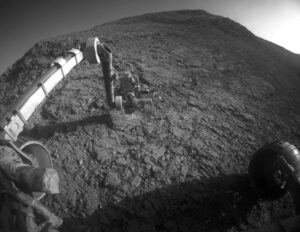
The image was taken by Opportunity’s front hazard avoidance camera on Jan. 5, 2016, during the 4,248th Martian day, or sol, of the rover’s work on Mars. This camera is mounted low on the rover and has a wide-angle lens.
Photo Credit: NASA/JPL-Caltech
“We have scored a 300-million-mile, interplanetary hole in one, and we are inside an impact crater,” said Steve Squyres, speaking at a NASA media briefing then. Squyres was the principal investigator of the science payloads on both Opportunity and its twin rover, Spirit, which landed on the opposite side of Mars on January 4, 2004.
Opportunity and Spirit were the key components of NASA’s Mars Exploration Rovers (MER) mission, which had a primary goal to search for diverse rocks and soils on Mars and to characterize them for evidence of past water activity on the now dry, frigid planet. Beginning with NASA’s Mariner 9 mission in 1971-72, scientific evidence was building that the surface of Mars once contained water in large enough quantities to shape the landscape.
With its dual panoramic cameras mounted on a mast about 5 feet above the surface of Mars, Opportunity provided stunning 3-D views of the planet from a human perspective. The rover’s robotic arm could articulate to analyze rocks and soil with a suite of instruments, including the Rock Abrasion Tool, which stripped away the surface of rocks to expose fresh interior material, the Microscopic Imager, which took high-resolution, magnified images, and the Alpha Particle X-Ray Spectrometer, which used radiation to reveal the elemental chemistry of samples.
The Meridiani Planum, where Opportunity landed, is a massive impact crater that evidence indicates was once filled with a body of water larger than Lake Superior. Spirit landed on the opposite side of Mars at Gusev Crater, a depression about 103 miles across, thought to have formed by an impact about 4 billion years ago. Evidence indicates the rocks and soil at this crater were also affected by the presence of water.
The first image Opportunity transmitted to Earth was a high-resolution color panorama from the floor of what was eventually named Eagle Crater. The 24-frame mosaic showed a spectacular landscape marked by dark soil, brighter tracks from the rover’s six wheels, rock outcrops on the sloping crater walls, and a vast plain beyond the crater’s rim. And it didn’t take long for Opportunity to photograph something far more significant. By mid-February, the rover had transmitted images of curious small orbs on the crater floor that were dubbed “blueberries” by the team.
“What we learned over time was that these things are what geologists call concretions,” Squyres said on a 2018 episode of NASA’s Gravity Assist podcast. “They’re made of hematite. That’s an iron oxide. …The way concretions form on Earth is typically you have rock that is saturated with liquid water, and there’s some mineral in it that’s super saturated and wants to precipitate out, and it does, and it finds the little nucleation point, and then it grows kind of adding layer upon layer and building a little hard spherical nodule like the way an oyster builds a pearl. So, this was clear evidence that the ground here had just been soaked with liquid water in the past.”
Opportunity landed on Mars 20 years ago this month with a 90-day primary mission. Over the next 14 years and 5 months, the rover would stun the team with its durability. Opportunity travelled a total of 28.06 miles on Mars, transmitting more than 217,000 images to Earth, including 15 360-degree color panoramas. It found evidence that Mars was once much warmer, with ample water, hot springs, steam vents, and volcanic eruptions.
“From the get-go, Opportunity delivered on our search for evidence regarding water,” Squyres said. “And when you combine the discoveries of Opportunity and Spirit, they showed us that ancient Mars was a very different place from Mars today.”
Opportunity’s solar power generation dropped precipitously in June of 2018 when a massive dust storm engulfed much of Mars. After the dust cleared, NASA was unable to reestablish contact with the rover. To learn more about the MER mission, click here.






